Nowadays, many parents believe that even before entering the first grade, a child should learn not only to write and count, but also to know the basic techniques of algebra: addition, subtraction, multiplication and division. That is why mothers and fathers face a serious question: “how to teach a child to learn the multiplication table”?
Basic rules for optimal results
Of course, you can teach a child using basic methods (they are described below). However, parents who are tuned in to how easy it is to learn the multiplication table for a child should not only learn special tricks (with which you can teach your child the multiplication table much easier and faster), but also choose the most optimal method for your baby.
Regardless of which method you choose, you must carefully observe the following rules:
- To make learning easy for a child, frequent breaks are necessary;
- An objective assessment of the baby's abilities is necessary: a preschooler simply cannot physically learn the entire multiplication table in three hours;
- Be sure to praise your child for every success, no matter how small;
- It is strictly forbidden to scold a child if he cannot learn something. It is best in this case to take a short break, and then return to the stumbling block again;
- Try to turn the study of the multiplication table into a game: if the child is interested and fun, then all knowledge will be absorbed much faster than if parents force the fidget to sit at boring books.
The basic way to learn the multiplication table
A parent who seriously thinks about how to learn the multiplication table with a child can recall his own childhood in a burst of inspiration: counting sticks, a school board, a strict teacher and a huge table completely filled with numbers. It is this table that is most often used in schools, so it is recommended to conduct at least the first lesson with it.
First you need to print (or draw) two versions of the tables: the first is completely filled, and the second is only with numbers around the edges. It is desirable that the second table be large, since the child will enter the numbers on his own.
At the first lesson, try to explain to the child the basic meaning of multiplication: this is the same addition, only multiple. Take small numbers as an example to show how multiplication works. An example might look like this:
“Here are the numbers two and three. In order to multiply three by two, we need to add three and three. How much will it take? That's right, six!"
What should be done after the first “trial” lesson with the table?If everything went well, try working with the table again: explain to your child the peculiar “mirroring” of multiplication:
“Now let's see how much is two times three. In order to calculate this, we need to add a two to the deuce, and then add the deuce again. Let's write them down in a column. How much will it take? Clever, six! You see, three times two is six, and two times three is six. So you learned the first rule of multiplication: by changing the factors (these are the numbers that you multiplied), the product (this is the number that you received in the answer) will not change!”
Be sure to praise your child.
“See how fast you counted! Learning the multiplication table is easier than it seems at first glance!”
Be patient.
If a child cannot quickly perform an addition operation, there is no need to prompt him: he will definitely count himself, he just needs more time than an adult.
If it took a little time to explain this rule, then you can start filling in the part of the multiplication table with the number 1 (usually children quickly understand the meaning of multiplying by 1). As soon as the baby's attention begins to dissipate, the lesson should be stopped - the preschooler will not learn more material.
When you click you will have a large printable table
Subsequent classes
Make a large number of cards with examples from the multiplication table. Before each lesson, be sure to let the baby solve familiar examples, otherwise the knowledge will simply be forgotten.
Small tricks will help you remember the results easier
After the kid learns multiplication involving one, you can try multiplying a number by a ten, or a dozen by a number. Teaching a child to assign an extra zero to each number will be much easier than, say, teaching him to multiply numbers by six.
Multiplication by two, three and four. Usually these actions do not constitute special work, because they can be easily counted on the fingers.
How to teach a child to multiply by five? It's very simple: any even number will end with 0, and odd - with 5. Counting them is a matter of technology.
Here is practically learned the entire multiplication table. But how to learn easily and quickly multiplication by the most complex numbers: six, seven and eight?
Most likely, they will simply have to be memorized: even adults often get confused in multiplying these numbers.
Is there an alternative to a table?
If during the first lessons you see that it is clearly difficult for a child to remember even the simplest examples, in no case do not swear at him, but start trying alternative methods.
 The method of studying the multiplication table with the help of verses seems interesting: now there are whole books that make it possible not only to easily pull up “falling” numbers, but also to learn the multiplication table from scratch. Fairy tales about numbers are also interesting: they can jokingly tell about one of the most difficult operations of mathematics to understand: multiplication.
The method of studying the multiplication table with the help of verses seems interesting: now there are whole books that make it possible not only to easily pull up “falling” numbers, but also to learn the multiplication table from scratch. Fairy tales about numbers are also interesting: they can jokingly tell about one of the most difficult operations of mathematics to understand: multiplication.
However, studying with the help of poems or fairy tales alone can be endlessly long without the use of such an additional technique as example cards. Remember that the child's brain needs relentless repetition - only then will the information be not only mechanically learned, but also conscious. And this is a guarantee that the baby will not forget the multiplication table until old age.
How to understand in advance whether it is easier to learn the multiplication table by a simple table or by adding poetic games with a child? Remember the character of the kid: if he is a pronounced humanist, then the games will definitely appeal to him, thereby making the learning process more exciting.
Toys always help
If you have absolutely no idea how you can quickly help your child learn this complex multiplication table, then use win-win: baby's favorite toys.
 The only criterion for toys is that any outsider should easily understand that they illustrate precisely multiplication. For example, when multiplying two pupae by three, exactly six pupae should be obtained, and not four pupae, a puppy and a crocodile (in this case it will be extremely difficult to teach a child!). Also, if you have chosen learning with toys, then you should not try to teach your child to count on his fingers instead - these are two completely different methods!
The only criterion for toys is that any outsider should easily understand that they illustrate precisely multiplication. For example, when multiplying two pupae by three, exactly six pupae should be obtained, and not four pupae, a puppy and a crocodile (in this case it will be extremely difficult to teach a child!). Also, if you have chosen learning with toys, then you should not try to teach your child to count on his fingers instead - these are two completely different methods!
One of the most interesting ideas was the idea of one father to put into action a huge amount of parts from LEGO, which were scattered in huge quantities throughout the apartment. Taking the smallest detail as a unit, the father began to show his son the basics of multiplying by two, by three and by four (after all, there were a lot of LEGOs, so they did not experience a shortage of pieces). As a result, all classes were held in the form of a game, and the father could not even think that it would be so easy and fast to teach his son to multiply!
Fingers and multiplication
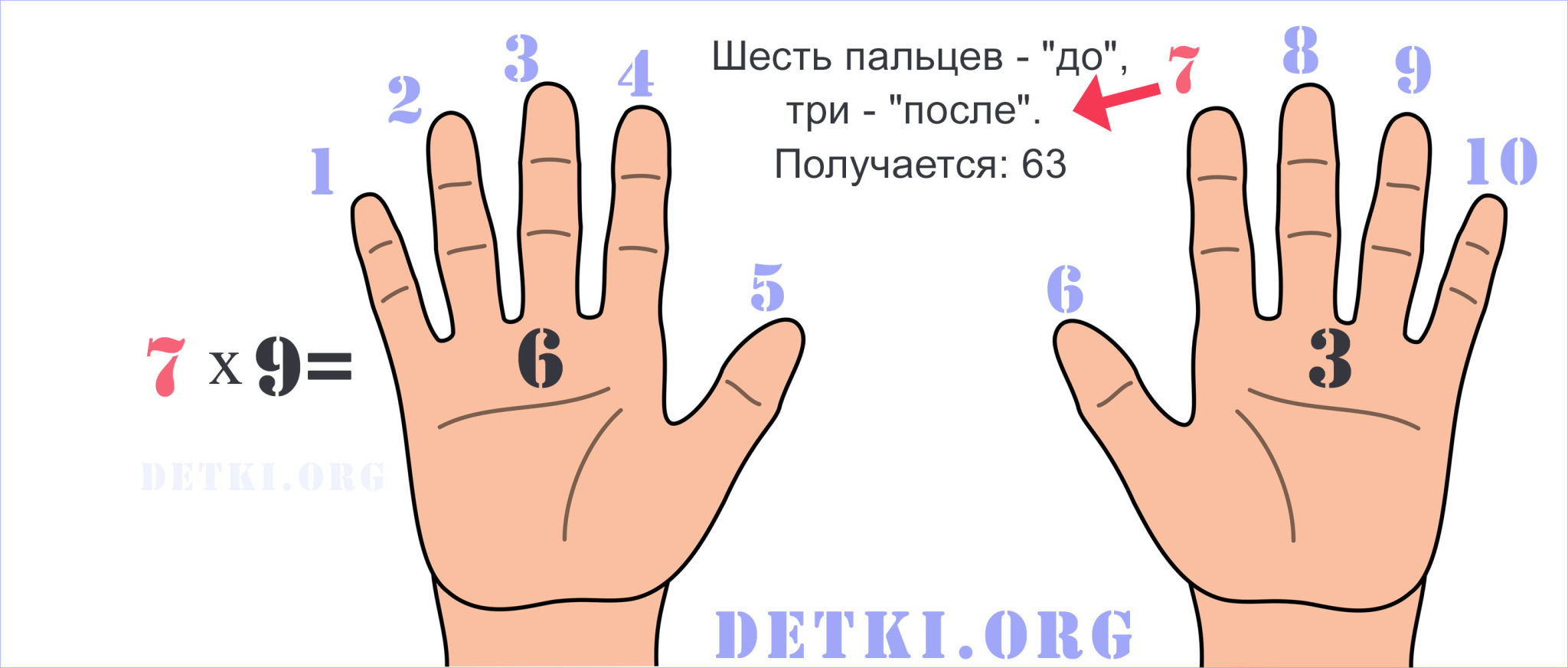
Multiplying by NINE with your fingers - the result is instant
Oddly enough, but you can quickly learn the multiplication table even on your own fingers!
Many parents disapprove of the habit of children to check all the results of calculations on the fingers, arguing that it is easy to count only small numbers on the fingers.
In fact, this is not entirely true: you can easily learn the multiplication table (and quite quickly!), Using only your own fingers and knowledge of interesting mathematical patterns (however, this will not save the kid from solving examples to repeat the material).
Of course, with the simplest examples, everything is clear: ten fingers are enough for the calculation. But what about multiplying by nine?
In fact, you can: for example, multiplying by nine is insanely fast: in just one step. It is necessary to count (starting from the left thumb) up to the number that we multiply by nine (or by which we multiply nine). Numbers to the left of it will give tens, and numbers to the right will give ones. This is truly a fantastic way. Much easier to multiply by nine.
Of course, it is extremely difficult to learn a table in this way without repetition, therefore, when choosing this approach, a large number of practical tasks are required.
Change is needed
Regardless of the age of the baby, he needs a large number of breaks (preferably every 10-15 minutes), otherwise it will not be easy to learn the basic laws of multiplication: after 10 minutes of continuous training, the child will continually be distracted by a cat, a ray of the Sun looking out the window, ringing in the street and so on.
How to maximize the level of effectiveness of classes? First, it is worth drawing a table with a clear lesson plan (it should contain small breaks) and follow it all the time.
Secondly, it is necessary to show imagination: you can learn the material in game form. For example, you can create your own card game.
Game example: cards are created (their number may vary, repetitions and bonus cards are possible). The main thing is that the child knows all the examples on the cards involved in the game. The basic rule of the game is that the player, without looking, draws a card and solves an example in a certain time. The one who scores the most points wins. Bonus cards can add an amount of time, give you the option to choose an example, and so on.
Thirdly, feel free to divide into parts: learning one large table is more difficult than many small tablets.
In addition
- It would be a good idea to hang a table above the baby's bed, as well as in his playroom: even without studying, he will automatically glide over it with his eyes, thereby gradually remembering the numbers;
- Train all the skills of the child more often: instead of multiplying seven by eight, invite the child to name numbers that, when multiplied by each other, will give 56;
- If your child is already in school, ask the teacher about her teaching methods. It may be worth using a similar method to learn the material faster;
- Be patient: it is easier for a child to learn the material when he is not limited in time, at least at first.
When a student faces the task of learning the multiplication table, then, of course, parents want to help him and are looking for which one is the best. There are a lot of techniques, but everything needs an individual approach to your little one. We will tell you about how you can easily explain the principles of multiplying numbers to your child and help him remember it in the shortest possible time.
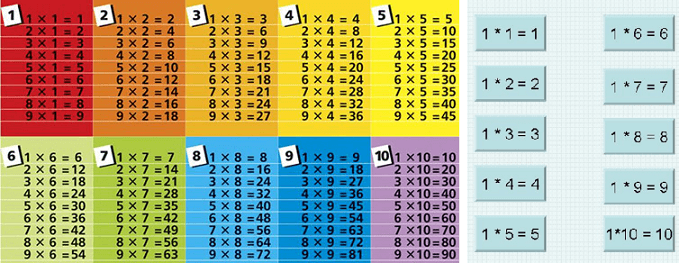
Most likely, it will be easiest for a student to multiply by 1 and 10. This account is given very easily to kids, since there is nothing terrible and difficult. Try drawing some examples in front of the baby, such as 1*2=2, 1*5=5, 8*1=8. In any case, the number will remain unchanged.
With the 10th it will be a little more complicated, but if you explain everything to a child of 8-9 years old, that multiplying by 10 is similar to the principle by 1, but you need to add 0 to the result, then the kid will remember it very easily. Be sure to tell your student that, having learned multiplication by 1 and 10, he will already know the first and last line in all other columns.
Multiply by 2
With a deuce, it will also be easy, since you will tell the baby that the correct result can be obtained by adding the two proposed numbers. For example, if a child has an example of 2 * 6, then he just needs to add 6 + 6 together and get 12. After each lesson, be sure to take a break for at least an hour, and it is best to continue classes every other day.
Multiply by 3
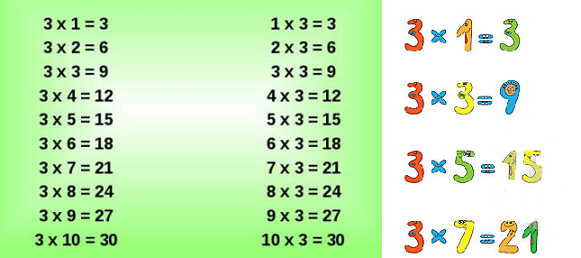
With multiplication by three, you can try the same method as with two. You just need to explain to the child that 3 * 4 and 4 + 4 + 4 will equally equal 12. If this method is absolutely not suitable for your child, then try playing with associations. First, ask the baby to dream up and draw his associations to the numbers from 1 to 9.
After that, start making up a story for each example, and so the student will remember the 3 sign much faster. Let your child play with these drawings and make up stories for them. You can draw your own story for each example, so it will be much easier to remember.
Multiply by 4
To make it easy for your baby to remember multiplying by 4, remind him of the principle that was used when he studied columns with a deuce. But only now we will need to double the desired number and double the result. For example, 4*4= 4*2=8*2=16.
Multiplication table 4
Multiply by 5

When studying the action by 5, you should immediately draw the attention of your 8-9 year old child to the fact that on the result of multiplication in this column, all results will end either in 5 or in zero. Also note that 5 is half a dozen. Therefore, the answers will be easier to multiply the number not by 5, but by 10 and then divide the result in half. For example, we need to find the answer to the example 7*5. Try 7 * 10, it will be 70. Now divide 70 by 2 - it will be 35.
Multiply by 6
For the six, there is also a way to make memorization easy for children of 8 years old, and this column of the plate was learned in an hour. Try to remind the kid how he learned the tablet for 3 and invite him to add the same number to the result. For example, 3*5=15 means 6*5=3*5+15=30.
Multiplication table 6
Multiply by 7

If multiplying to 6 is no longer a big deal for a child of 8 years old, then understanding how to multiply by 7 will be easy for him. If you need 7 * 2, then you just need to add 7 and 7, you get 14. An example of 7 * 4 will mean that the number needs to be doubled twice and so on. Separately, you will need to write down and learn only the multiplication by 7, 8 and 9.
Multiply by 8
By analogy with the previous methods, multiplying by 8 can be compared to four, only the result will need to be doubled three times. If in our example it is written that 4 * 8, then we multiply 2 by 4, the resulting eight by two more, we get 16 and then we multiply this result by another 2 and get 32.
Multiplication table 8
Multiply by 9
There is a simple and very easy method for multiplying by 9 on your fingers. It will definitely appeal to children 8-9 years old, since you can learn it in just a few minutes, and not in an hour or two.
Ask the student to place their pens on the table, palms down. Count your fingers from left to right. So, for example, we have an example of 7*9. We count 7 fingers on the right. We bend the finger on which we stopped the count. How many fingers are not bent to the left of the seventh - six.
So, we will have six tens in the answer. How many fingers to the right of the bent one - three. This will be the number of units in the answer. So we realized that the answer is 63. Such a study of the multiplication tablet on the fingers will be useful. Do not scold the baby that he uses this method for too long. It is this method that will allow the baby to firmly and firmly remember the multiplication by 9.
Multiplication table 9
How to multiply numbers by a column
Of course, after a child of 9 years old has learned the multiplication table well, he will need to be taught to multiply two-digit ones in a column, and then three-digit numbers. Numbers that are multiplied by each other are called multipliers. They are called the first multiplier, the second multiplier, and so on. The result of multiplication will be called "product".

To multiply two numbers, you will need to arrange them in a column on top of each other so that units are above ones, tens over tens, and so on. The next step is that the top number will need to be multiplied by the digit of the bottom number. First, one is multiplied, then tens, hundreds, and so on. The result must be written below the line.
If as a result of multiplication you get a number that is more than ten, that only the last digit of the result goes under the line, and ten, if any, is written on top. Then this ten must be added to the result of multiplying ten by one. Multiplying the top number by tens and hundreds of the bottom number follows the same rules.
If you give your child the opportunity to calmly learn this or that method of memorizing the multiplication table, then he will quickly begin to count. Do not insist if the baby does not want to engage. You may well follow the lead of the child, allowing him not to repeat the table.
show him concrete examples in life, where the table can be useful to him. For example, ask your daughter to count how many sweets you need to buy so that her girlfriends all get three. It will be easy and interesting for a girl to find the answer, since this directly concerns practice and life.
Parents at some point are faced with the problem of teaching the child the knowledge of the multiplication table. Today, a lot of ways are known for this, but not every one of them is truly effective. Each child needs a special approach, the application of one or another teaching method. And yet, what fast way learn the multiplication table: how to help your child learn the multiplication table?
How to learn the multiplication table for a child easily and quickly
At the first training stage, the kid should explain the features of the actions of multiplying a number by a number. In most cases, children, starting to learn the multiplication table, have an idea about the simplest arithmetic operations for addition or subtraction. Therefore, it is easy for you to explain to the baby that multiplying a certain number by two means only that this number is added twice. The child learns to be clearly aware of this, so that in further learning he does not experience difficulties. Try to explain to the kid the principle of the multiplication table, how to use it in this or that case, in order to correctly determine the answer.
Learn the table easily and simply
We know that even in the most ordinary educational process there must be a game factor necessary for the children to better assimilate the material. Such a technique will captivate the child, make him feel the essence, interest the mind in that it is simply necessary to know the multiplication table. table, you solve half the problem.
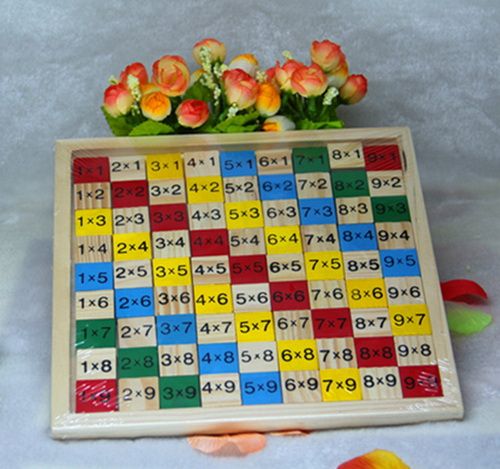
It is very popular in teaching multiplication fun game into cards.
- Its essence lies in the fact that the baby randomly pulls out a card from a pack and sees on each of them the action of multiplying two numbers that does not have an answer.
- When determining the correct result, the card is eliminated from the game, otherwise, it is returned to the common pile again. It is recommended to play until the cards become answered, that is, until the kid correctly solves all the multiplication examples.
- When there are few cards left, they usually contain those examples that the child tried to answer. Thus, there is a process of repetition, the search for the right solution. Memorization is easier. The child even experiences a slight excitement.
This is called exercise. The convenience lies in the fact that it is carried out in stages, based on the material covered. They start with examples for a deuce, gradually diluting the stack with other cards to complicate the actions.
Having decided to start learning the multiplication table, explain to the child simpler examples that can be solved without much difficulty. A large table can frighten a baby, but he should be inspired that there is nothing terrible and complicated in it.
- For example, the kid should firmly understand in the first lesson that any number multiplied by one remains unchanged. And the action with a ten means that zero is simply attributed to the multiplied number in the mind. Thus, the child must first learn the multiplication by one and ten. You should not be forced to learn everything at once. If the baby is tired - give him a break. But if the child himself shows interest in the process, continue.
- Multiplication by two is easy to learn. It means the usual addition of two same numbers. Knowing how to add, the baby will easily master the multiplication by this number.
- Next comes the complexity. The kid must learn to understand that by changing the places of factors, their product will not change. In other words, teaching will go easily if the child understands that multiplying two by three will be the same as multiplying three by two.
- Using such simple tricks, you can easily teach your baby some tricks of the multiplication table. And keep repeating that there is nothing complicated about it.
- Having mastered the simplest actions, go with the child to more serious multipliers. In this case, in addition to the game, it is allowed to use other methods - memorization, association, repetition, division into constituent parts.
- Some examples will simply have to be memorized, memorized and constantly repeated so that the child remembers them firmly. It is recommended to move in order, do not try to memorize everything at once. You should not try to learn the table from the end, so as not to scare the baby with unjustified difficulties.
How to quickly learn the multiplication table for 9
For quick memorization multiply by nine, use your fingers. The fingers of the left hand are tens, on the right hand they are units. Pull them out in front of you and with the words nine times one - bend the thumb of your left hand. As a result, after the bent finger, nine remains. When multiplying a nine by a two, bend the index finger of your left hand. You will get one in front of the bent finger on the left hand and eighteen after the bent eight. And so on. The technique works up to multiplying nine by nine.
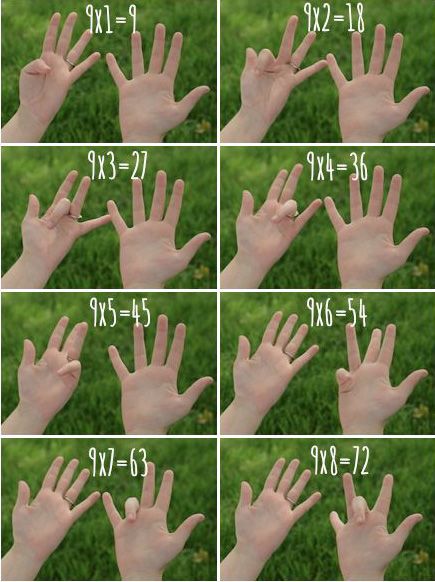
Cheat sheet multiplication by 9. We write a multiplication table by 9, after the equal sign we first write from top to bottom from 0 to 9. Then from bottom to top from 0 to 9 and we get a table of correct answers:
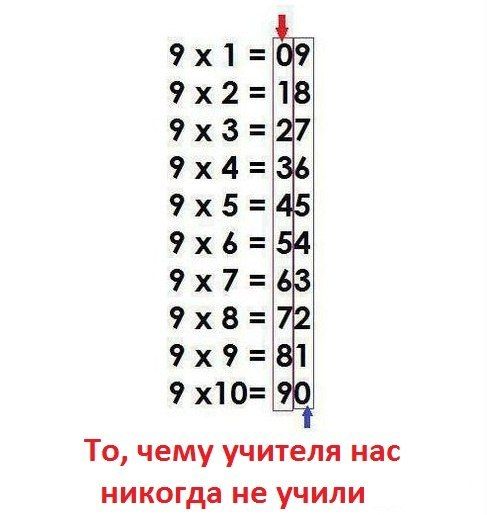
In training, do not tire the baby, constantly smile, praise success in answers, arrange fun moments of relaxation. Do not call him stupid, half-educated and other offensive words. Remember that the baby is not a counting machine, the speed of answers is caused by banal memorization, and not by understanding the situation. After the multiplication table has been studied in full, the baby will no longer need oral methods of calculation, solving examples and problems in arithmetic.
At first glance, the multiplication table seems cumbersome. 100 items! The child probably does not even expect that this will have to be taught. But there are several ways to learn this table faster than cramming. Some of them are complex and not very effective, while others are very effective.
And one of those effective methods I will share. He based on the sequence of studying individual tables for individual numbers and knowledge of some of their regularities.
How to quickly memorize the multiplication table
Half of the multiplication table does not even make sense to learn.
Multiply by 1, 2, 10. It's obvious how to multiply numbers by 1 and by 10. And multiplying by 2 is a very simple addition of a number to itself.
2 x 2 = 2 + 2 = 4
6 x 2 = 6 + 6 = 12
9 x 2 = 9 + 9 = 18

Accordingly, by the time you learn the multiplication table, the child should know what addition of numbers is. Now that we've dealt with multiplication by 1, 2, 10, we're left with a table of just 49 elements.
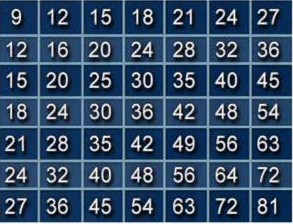 Remaining table
Remaining table Multiply by 3, 4. The main difficulties that I have noticed when memorizing the multiplication table are multiplications by 3 and by 4. Once you learn this, there is very little left.
I propose to learn the sequence (the results of the product of numbers when multiplied by 3): 3, 6, 9, 12, 15, 18, 21, 24, 27, 30 so as to learn how to quickly name this sequence.
Thus, we compare the sequence (the results of multiplication by 3) that we learned earlier with the factors of the number 3. Next, I propose to do this in any order:
"3 times 3" is 9!
"3 times 1" - 3!
"3 times 7" is 21!
Until you learn to multiply by 3.
We do the same with multiplying by 4. We learn the sequence 4, 8, 12, 16, 20, 24, 28, 32, 36, 40.
We consistently pass
"4 times 1" - 4!
"4 times 2" is 8!
"4 times 3" is 12!
"4 times 4" - 16!
…..
"4 times 10" - 40!
Multiply by 5. Multiplication by 5 is easy to learn, because Any number multiplied by 5 ends in either 0 or 5.
Multiply by 9. There is an interesting trick for multiplying by 9
9 x 1 = 09
9 x 2 = 18
9 x 3 = 27
9 x 4 = 36
9 x 5 = 45
9 x 6 = 54
9 x 7 = 63
9 x 8 = 72
9 x 9 = 81
9 x 10 = 90
First, the sum of the digits of the product gives us 9.
9 x 2 = 18 (1 + 8 = 9)
9 x 3 = 27 (2 + 7 = 9)
9 x 4 = 36 (3 + 6 = 9)
9 x 5 = 45 (4 + 5 = 9)
Secondly, the number of the 9 multiplier is 1 greater than the first digit in the result of the product
9 x 2 = 18 (9 x 2 starts at 1)
9 x 3 = 27 (9 times 3 starts with a 2)
9 x 4 = 36 (9 x 4 starts with 3)
9 x 5 = 45 (9 times 5 starts with a 4)
Using these 2 facts, you can greatly simplify the task of remembering multiplication by 9.
Now that we know the multiplication table for 1, 2, 3, 4, 5, 9, 10. There is a small piece left:
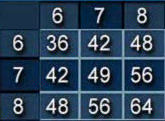 Easy to remember
Easy to remember Many find it easy enough to learn how to multiply a number by itself (the square of a number)
6 x 6 = 36
7 x 7 = 49
8 x 8 = 64
And then there are 3 "complicated" facts:
7 x 6 = 6 x 7 = 42
8 x 6 = 6 x 8 = 48
8 x 7 = 7 x 8 = 56
They just need to be learned.
As a result, having decomposed everything into phased steps, we understand that remembering the multiplication table is not so difficult.
To repeat the multiplication table, I advise you to use cards, but it is for repetition!
Just go through all the steps in sequence and repeat the memorized table on the cards and quick results will not keep you waiting!
Knowing the multiplication tables by heart is one of the prerequisites for successful study. modern child. Often, our children find it difficult to memorize both the entire table and its parts. We have already written about the multiplication table in verse and today we want to continue this interesting topic.
Vladimir Bublik offered his own version of how to quickly learn the multiplication table. He writes: Visually, quickly, cheerfully, consistently and naturally, the child learns the basics of mathematical logic. In a short cartoon on the motive Look, we liked:
Educational channel for children Kapuki 4 Plus offered his original version of the study of the multiplication table based on the famous computer game Angry Birds:
We also tested another simulator to test knowledge of the multiplication table. We took 1720 place by correctly answering 10 questions out of 10. Try it, maybe you can do better?
Our colleagues from 4brain.ru offer various options for memorizing the multiplication table, in particular in the form of playing cards or poems by Marina Kazarina About multiplication and Alexander Usachev Multiplication, they are on our website. Oksana Turkina's video with multiplications on fingers seemed to us not very simple, but nevertheless, maybe it will be useful to you.
The site multiplication.com (in English) invites children to solve multiplication examples during the game. We chose this one, with a helicopter. The task is to convey the desired load 24, 85 or any other to the correct answer. The advantage of the game is that the child has time to think while he controls the helicopter. You can play. In addition to this game, there is also



